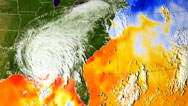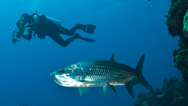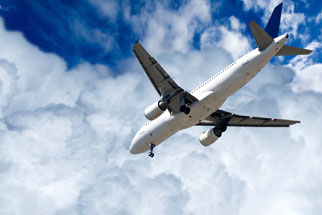Better Forecasts for Aircraft
- By David Levin
- Posted 09.02.10
- NOVA
To keep airline flights safe, it's essential to give pilots and air traffic controllers accurate forecasts. That's not much of a problem over land, but over the ocean, a lack of surface weather sensors makes it a challenge. Engineer Bruce Carmichael from the National Center for Atmospheric Research thinks new supercomputer-based forecasting technology could help.
Transcript
Better Forecasts for Aircraft
Posted September 2, 2010
DAVID LEVIN: You're listening to a NOVA podcast. I'm David Levin.
On any given day, nearly 30 thousand airline flights take to the sky in the United States. And each of these flights is at the mercy of the weather. Thunderstorms, turbulence, ice, blizzards — they're all big safety hazards for aviation.
BRUCE CARMICHAEL: Weather is responsible for a significant number of accidents. if you can remove the weather component of the safety issue, you've made a huge stride toward improving our safety record.
DAVID LEVIN: That's Bruce Carmichael from the National Center for Atmospheric Research. He's looking into ways to improve weather prediction for aviation. To keep flights safe, he says, it's important to give pilots and controllers accurate forecasts.
Over land, that's not too much of a problem. Forecasters can pull information from a lot of sources on the ground, like radar and surface sensors. But for flights over the ocean, it's much more of a challenge.
BRUCE CARMICHAEL:We don't have ground-based sensors—I mean, really, over the ocean, all we have is satellite information. So our weather forecasts are not as good.
DAVID LEVIN: To compensate, all commercial flights use onboard radar when flying over the ocean. It's a powerful tool, but it can only see the skies in front of an aircraft. That makes it hard for pilots to know which way to turn if they run into a line of storms.
BRUCE CARMICHAEL: For example, a decision as easy as, "I know I'm not going to fly through that thing in front of me, but should I go left or should I go right?" That's a very hard question to answer with an on-board radar. To do that, you really need some sort of information to show you a more strategic view of where you are and what's around you and what you're going to encounter.
DAVID LEVIN: Satellites are a partial answer—but since they look down on weather from above, they only offer a two-dimensional picture. But it's possible to fill in the gaps using computers. By feeding satellite data into a computer model of the atmosphere, forecasters can predict storms along an aircraft's flight path—even ones that might pop up an hour or two in the future.
BRUCE CARMICHAEL: And so, we basically allow the model to begin to forecast forward. So we want to know not only what's there right now, but as best as we can, where do we see it going and how do we see it evolving into the future?
DAVID LEVIN: Although these forecasts aren't perfect, Carmichael thinks they would be a valuable tool for airline pilots.
BRUCE CARMICHAEL: That's really the kind of thing that you need depicted in the cockpit in a way that's easy for the pilot to comprehend. Where the pilot can say, "A-ha, my flight path is headed right through the middle of this thing. I need to think of a different plan."
DAVID LEVIN: There are already a few companies making in-cockpit weather displays for private aircraft, but they're not available yet for commercial flights. Carmichael says that's partially because of Federal Aviation Administration rules. Certifying new equipment for an airline can be sort of like getting a new drug approved. It takes years of careful testing and in-flight trials—and it's not cheap.
BRUCE CARMICHAEL: There's a significant cost to implement it in each and every airplane in the fleet. And there's a training cost in training the pilots to use the technology effectively and the training cost for the people who maintain the aircraft to maintain the equipment and keep it running.
DAVID LEVIN: According to the Air Transport Association, a group that represents airlines, a commercial version of the technology was tested in 2006, but it's still under development. Carmichael is hopeful that it'll be ready in the next few years.
BRUCE CARMICHAEL: Well, of course, being a weather person, I always approach this from the standpoint that weather is the most critical thing in aviation. But in my saner moments, I realize that there are a lot of issues that the FAA and the airlines have to consider to maintain a safe and efficient system, and weather is just one of many.
DAVID LEVIN: It all boils down to priority, he says. Is weather forecasting more or less important than, say, runway safety? Or improved navigation? That's an ongoing debate.
BRUCE CARMICHAEL: A lot of people have a lot of really good ideas for technology to improve safety or capacity or efficiency in the system. So, between the airlines, the airports, the FAA, everybody is always doing this tradeoff game about, there's only so many dollars available to do stuff. Where's the biggest bang for the buck?
DAVID LEVIN: For NOVA, I'm David Levin.
Credits
Audio
- Produced by
- David Levin
Image
- (aircraft)
- © seraficus
Related Links
-

Crash of Flight 447
Forensic investigators reconstruct the final moments of the Air France disaster.
-

Stronger Hurricanes
Is global warming making hurricanes more intense?
-

For Forecasts, Follow the Fish
Discover how animals are deepening our understanding of the oceans and sharpening the accuracy of weather forecasts.
You need the Flash Player plug-in to view this content.


